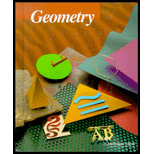
a.
To describe the
a.
Answer to Problem 10E
The four lines symmetries of the square do not form a subgroup, as there is no identity.
Explanation of Solution
Given information:
The figure of a square.
A pattern in which there is a congruent copy of a figure completely fill the plane without overlapping is called Tessellation.
A tessellation of the figure. This pattern has point symmetry and translational symmetry.
The figure of tessellation has the four rotational symmetry. Each symmetry has center O and rotates the figure onto itself. Note that
The identity mapping always maps a figure onto itself, we usually include the identity when listing the symmetries of a figure.
The group table is given below,
| | I | | | |
| I | I | | | |
| | | I | | I |
| | | | I | |
| | | | | I |
Therefore,
The four lines symmetries of the square do not form a subgroup, as there is no identity.
b.
To describe
b.
Answer to Problem 10E
The mapping that maps every point to itself is called identity translation, hence the translation of T followed by
The symmetry of
Explanation of Solution
The mapping that maps every point to itself is called identity translation, hence the translation of T followed by
Therefore, the symmetry of
c.
The find the symmetries of the tessellation.
c.
Answer to Problem 10E
The tessellation has four symmetries.
Explanation of Solution
Given:
The figure of the tessellation of fish.
Concept Used:
The figure of tessellation has the four rotational symmetry. Each symmetry has center O and rotates the figure onto itself. Note that
The identity mapping always maps a figure onto itself, we usually include the identity when listing the symmetries of a figure.
d.
To find the symmetries satisfy the four requirements for the group.
d.
Answer to Problem 10E
The symmetries satisfy the four requirements for the group
Explanation of Solution
Given:
The figure of the tessellation of fish.
Concept Used:
The group is commutative if it has four property,
- The product of two symmetry is another symmetry.
- The set of symmetries contains the identity.
- Each symmetry has an inverse that is also a symmetry.
- Forming of product is an associative group,
Therefore, the group is commutative as it is an abelian group.
Chapter 14 Solutions
McDougal Littell Jurgensen Geometry: Student Edition Geometry
Additional Math Textbook Solutions
Introductory Statistics
Pre-Algebra Student Edition
College Algebra (7th Edition)
Thinking Mathematically (6th Edition)
A First Course in Probability (10th Edition)
- Door 87.5in to 47 living 44.75 Closet 96in Window ISS.Sin 48in Train Table 96in 48in 132:2 Windowarrow_forward39 Two sides of one triangle are congruent to two sides of a second triangle, and the included angles are supplementary. The area of one triangle is 41. Can the area of the second triangle be found?arrow_forwardA parallelogram with an area of 211.41 m^2 hast a base Thatcher measures 24.3m. Find ist height.arrow_forward
 Elementary Geometry For College Students, 7eGeometryISBN:9781337614085Author:Alexander, Daniel C.; Koeberlein, Geralyn M.Publisher:Cengage,
Elementary Geometry For College Students, 7eGeometryISBN:9781337614085Author:Alexander, Daniel C.; Koeberlein, Geralyn M.Publisher:Cengage, Elementary Geometry for College StudentsGeometryISBN:9781285195698Author:Daniel C. Alexander, Geralyn M. KoeberleinPublisher:Cengage Learning
Elementary Geometry for College StudentsGeometryISBN:9781285195698Author:Daniel C. Alexander, Geralyn M. KoeberleinPublisher:Cengage Learning

